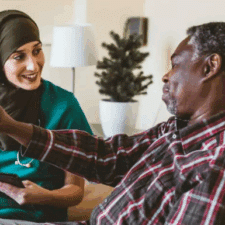
Thigh chafing happens when your thighs rub together whether or not they’re covered by clothing. It’s tempting to think that chafing only affects thick thighs but that’s not true. The issue can affect anyone regardless of their weight or size. With the temperatures rising, it’s important to note that you’re more likely to chafe when it’s hot so it’s good to know how to prevent it.
5 Ways to Prevent Thigh Chafing
1. Choose Your Clothes Well
Just because something is labeled as sportswear, it doesn’t mean it’s protective. Tight-fitting clothing that traps moisture can irritate the skin so doctors advise going for loose-fitting cotton clothes that let your thighs breathe while absorbing moisture. If you need tighter clothing for your activity, then look for items that absorb sweat quickly. Another issue that can irritate your thighs is the seam location. With new clothes, it’s good to try them out before using them for an extensive period.
2. Look for Helpful Additions
There are clothing items you can wear for extra protection. For example, thigh bands are silicone-based devices that reduce skin-on-skin friction. An alternative is thigh-chafing shorts that are designed to specifically protect your thighs.
3. Carry Back-up
Sometimes you can’t predict how a new activity or clothes may affect your thighs. In this case, it helps to bring a change of clothes so you can get some relief as soon as you feel the friction.
4. Use Anti-Chafing Products
Another way to protect your thighs is to use anti-chafing products like petroleum jelly, deodorant, baby powder, lip balm, dusting powder, and anti-chafing creams before you get active.
5. Check out Your Detergent
If you already have sensitive skin, some people have found that using a gentler detergent on their clothes reduces the likelihood of having irritated skin.
RELATED: Thick Thighs Save Lives: Why Bigger Thighs & Hips Are Healthier (Seriously!)
The Common Symptoms
Generally, thigh chafing looks like irritated skin. When the symptoms are mild you may see redness, darkened skin, flaky skin, a mild rash, or raised blisters. There might be stinging, burning, itching, or pain in the chafed areas. Sometimes, the pain can be intense when you do anything that makes your thighs come in contact with each other. If you don’t relieve the symptoms at this level, then you risk them getting worse.
People with severe symptoms can have swollen or broken skin, blisters, sores, or large welts. There can be muscle pain as well as bleeding. With the skin damaged, you’re more likely to develop secondary skin infections that need to be treated with prescribed medication.
For Black people, the most worrisome symptoms are darkened skin and those associated with inflammation. Studies show that Black skin is more prone to darkening – also known as hyperpigmentation – and the issue can linger for longer than other ethnicities. Black Americans are also more susceptible to inflammation when it comes to their skin. As a result, when your thighs are chafed, you may notice the symptoms more quickly and for a longer period. Worse yet, even after the inflammation is gone, you may still experience more hyperpigmentation.
Natural Remedies to Soothe Your Thighs
Mild symptoms of thigh chafing can be treated at home. Once you’re home, it’s good to let the area cool down by letting your skin breathe or by using an ice pack. Afterward, clean the area with a gentle, fragrance-free cleanser. It’s best to avoid harsh soaps or body washes until the skin is healed. The next step is to help your skin recover by applying some natural aloe vera gel to the chafed area. When you’re going to bed, covering your chafed thighs with petroleum jelly can be helpful.
While your skin is getting better, you should avoid clothing that will irritate the area. Light-weight cotton is usually your best bet to keep your skin healthy. Additionally, hold off on any activities that can irritate your thighs any further.
Depending on how bad your skin is chafed, you should eliminate the symptoms in a few days. If they are the same or get worse, you should talk to your doctor about treatment options. Some people need corticosteroids to reduce inflammation and antibiotic cream to deal with any infections.
Anyone can develop chafed thighs after being active but certain symptoms can be worse for Black people. It’s best to prevent the issue by wearing the right clothes and using anti-chafing products but that isn’t always completely effective. If your thighs chafe, take care of them quickly so the symptoms don’t get worse.








